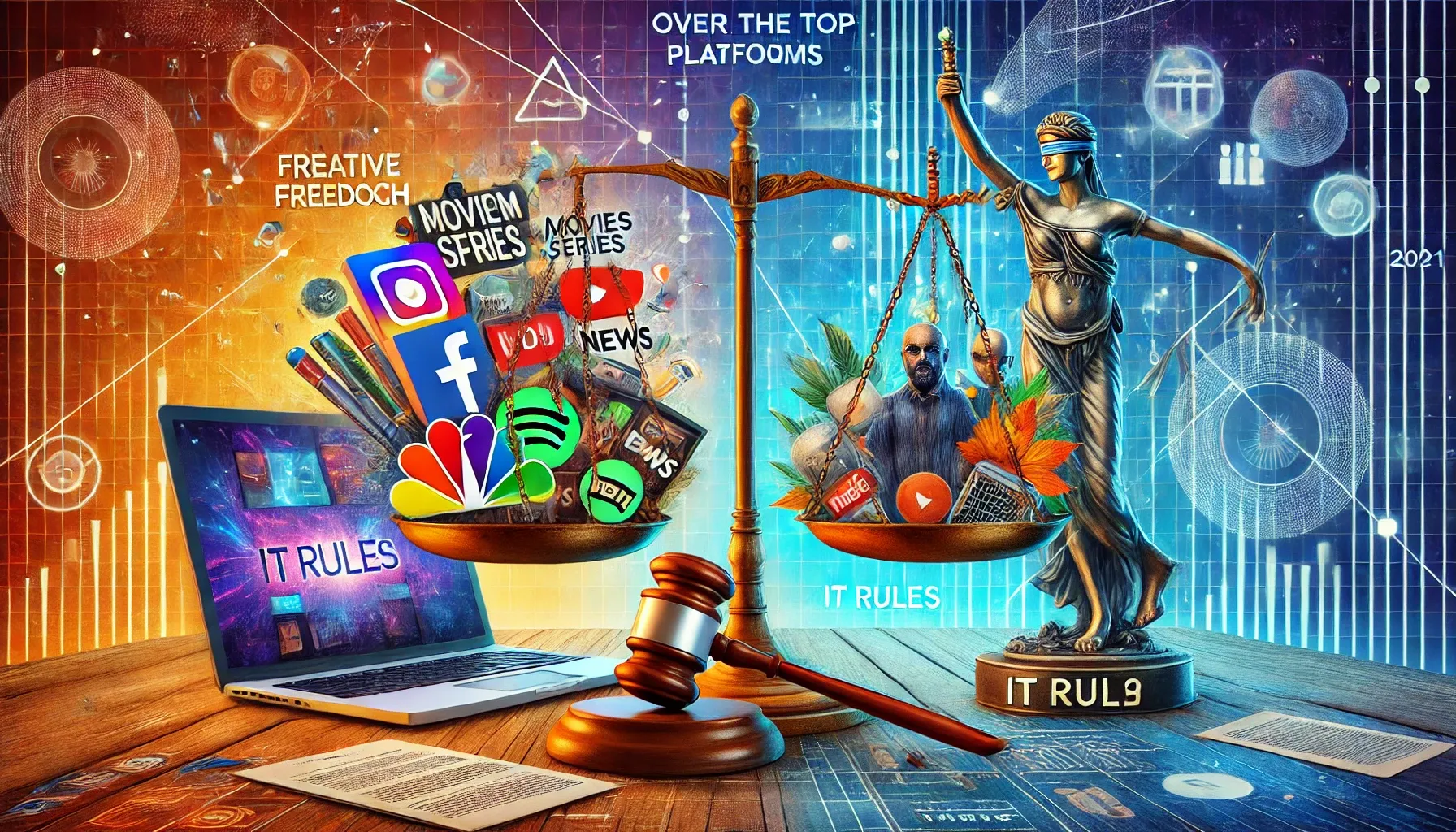The rise of OTT platforms in India has sparked a debate on balancing free expression and societal interests. The IT Rules, 2021, aim to regulate content with a three-tier grievance redressal system, ensuring accountability while addressing concerns over censorship.

Introduction
India, a country committed to democratic principles and freedom of speech, has been grappling with the challenge of balancing free expression with societal interests, especially in the era of digital media. In particular, the emergence of Over The Top (OTT) platforms, which provide vast arrays of content without much statutory regulation, has raised concerns about content moderation, censorship, and the need for oversight. This article explores the necessity of regulating OTT content, evaluating the viability of self-regulation, and considering the fair application of censorship under Indian law, particularly in light of the Information Technology (Intermediary Guidelines and Digital Media Ethics Code) Rules, 2021 (IT Rules 2021).
Overview of Censorship in India
- Censorship refers to the restriction or suppression of content deemed objectionable, harmful, or sensitive by a controlling authority. In India, censorship has evolved with changing media landscapes.
- Historically, the media played a critical role in informing the public and expressing diverse viewpoints. However, as new forms of media have emerged, the need to regulate and censor content to maintain societal harmony and protect public interests has remained a contentious issue.
- The Cinematograph Act of 1952 established the Central Board of Film Certification (CBFC) to regulate the public exhibition of films in India. This act prohibits the screening of films that conflict with public interests or violate standards of decency and morality. However, the application of such principles has often faced criticism for curbing the freedom of speech and expression.
- The Indian Constitution guarantees freedom of speech under Article 19(1)(a)[1], which is subject to reasonable restrictions under Article 19(2)[2]. These restrictions are grounded in public order, decency, morality, and the sovereignty of the state.
- In the landmark case of K.A. Abbas v. Union of India[3], the Supreme Court clarified that films can be subjected to censorship to ensure that they adhere to these constitutional principles. The Court emphasized that films, as a form of speech, must balance the freedom of expression with societal interests.
The Bandit Queen Case and the Challenge of Regulating OTT Platforms
- The Bandit Queen case[4] (also known as the Phoolan Devi case) highlighted the complexities surrounding the censorship of sensitive content. The film depicted graphic scenes of sexual violence, leading to a PIL that sought to halt its screening.
- The Supreme Court, however, ruled that the depiction of obscenity should be assessed in the context of the entire film rather than isolated scenes. The judgment underscored the notion that offensive content could not be arbitrarily censored without considering the overall impact and context.
- This case became pivotal in understanding the limits of censorship and how legal frameworks like the Cinematograph Act were insufficient to govern new media formats like OTT platforms.
- In Karnataka High Court's ruling, it was established that films streamed online did not fall under the purview of the Cinematograph Act, as the Act's scope did not extend to internet-based streaming. This ruling raised the need for a specific regulatory framework tailored to OTT platforms.
The Evolution of OTT Regulation in India: A Three-Phase Journey
The journey toward regulating OTT platforms in India can be divided into three distinct phases:
Phase I: Initial Growth and Minimal Controversy
In the early stages, OTT platforms were relatively new, and content experimentation was minimal. The sector experienced significant growth, particularly in the form of non-controversial, family-friendly content. With the increasing popularity of platforms like Netflix, Amazon Prime, and Hotstar, the call for regulation was minimal. However, as the market matured, calls for oversight grew louder.
Phase II: Emergence of Controversial Content
The release of Sacred Games on Netflix in 2018 marked a turning point. The show, praised for its bold content and storytelling, became the center of several legal challenges. Various FIRs were filed, and citizens approached courts demanding the removal of controversial content. During this phase, the government initially advocated for self-regulation, urging platforms to adopt voluntary codes of conduct, while the judiciary expressed concerns over the lack of regulatory oversight.
By the end of May 2021, OTT platforms had divided into two major regulatory bodies:
- Indian Broadcasting Foundation (IBF), which formed the Digital Media Content Regulatory Council (DMCRC).
- Internet and Mobile Association of India (IAMAI), which formed the Digital Publishers Content Grievances Council (DPCGC).
However, both bodies faced challenges due to the absence of an impartial enforcement mechanism.
Phase III: The Introduction of the IT Rules 2021
In November 2020, the Ministry of Information and Broadcasting (MIB) brought all OTT platforms and digital news websites under its regulatory oversight, culminating in the Information Technology (Intermediary Guidelines and Digital Media Ethics Code) Rules, 2021. This phase represents the government's formal recognition of the need for regulatory control over OTT content.
The IT Rules 2021 provided the framework for the self-regulation of OTT content while establishing a three-tier grievance redressal system. The MIB assumed a supervisory role, overseeing compliance with the rules and handling grievances from users.
Key Regulations for OTT Platforms under IT Rules 2021
Under the IT Rules 2021, OTT platforms, classified as “publishers of online curated content,” are required to adhere to the following regulations:
1. Content Classification and Age Ratings
OTT platforms must classify content into five categories:
- U (Universal)
- U/A 7+
- U/A 13+
- U/A 16+
- A (Adult)
Platforms must implement parental controls for content rated U/A 13+ or above. The classification rating and content descriptor must be prominently displayed at the beginning of each program to help users make informed viewing decisions.
2. Appointment of Compliance Officers
Platforms are required to appoint three compliance officers, all of whom must be Indian citizens:
- Chief Compliance Officer
- Nodal Contact Person
- Resident Grievance Officer
3. Grievance Redressal Mechanism
A three-tier grievance redressal system must be established:
- First Level: A grievance officer handles complaints, which must be acknowledged within 24 hours and resolved within 15 days.
- Second Level: Unresolved complaints are escalated to self-regulating organizations (SROs).
- Third Level: An independent oversight mechanism led by the MIB to resolve escalated complaints.
4. Monthly Reporting and Accountability
Platforms must publish a monthly report detailing user complaints and the actions taken in response. This transparency aims to ensure accountability and user trust in the grievance process.
5. Traceability and Content Moderation
Certain content, such as "violent or harmful material," must be traceable to its originator. Platforms are expected to maintain logs that can be used for investigating and addressing unlawful or offensive content.
Key Factors Intensifying the Debate on OTT Platform Regulation
The debate around OTT regulation is further intensified by several factors:
1. Offensive Content and Public Sentiments
OTT platforms have faced backlash for content that allegedly defames India’s political history, misrepresents cultural aspects, or promotes divisive themes. For example, shows like Tandav and Sacred Games have faced legal challenges for their depiction of sensitive issues.
2. Self-Regulation vs. Government Censorship
The self-regulatory bodies formed by industry stakeholders, such as the IAMAI and IBF, have been criticized for lacking impartiality and enforcement mechanisms. Critics argue that OTT companies should not be left to define what constitutes acceptable speech, as this could lead to biased censorship, especially regarding government policies.
3. Impact on Traditional Media
Traditional broadcasters and filmmakers have also raised concerns about OTT's unregulated growth, fearing it undermines established content standards and affects their business model. This has prompted calls for a level playing field across platforms.
The Impact of Censorship on OTT Platforms
Censorship in India plays an essential role in protecting public order and maintaining cultural sensibilities. However, it also has its downsides. Overzealous censorship often stifles creativity and restricts free expression, particularly when it involves critical voices. Moreover, censorship can be manipulated for political purposes, serving as a tool to suppress dissent.
In an ideal scenario, OTT platforms would be able to self-regulate content while maintaining diversity and creativity. However, the absence of such mechanisms often leads to content being either overly censored or unchecked, creating a tension between freedom of expression and societal responsibility.
Conclusion
As OTT platforms continue to expand in India, striking the right balance between regulation and freedom of expression remains a key concern. The IT Rules 2021 aim to offer a structured framework to manage content on OTT platforms, ensuring accountability while respecting freedom of speech. The question remains whether these regulations will effectively safeguard public interest without curbing creative freedom. If OTT platforms can adapt to these regulatory measures while maintaining their innovative edge, they could play a crucial role in the future of digital media in India.
[1] The Indian Constitution, art. 19(1)(a).
[2] Id. at 19(2).
[3] AIR 1971 SC 481.
[4] Bobby Art International, Etc v. Om Pal Singh Hoon & Ors, AIR 1996 SUPREME COURT 1846.


